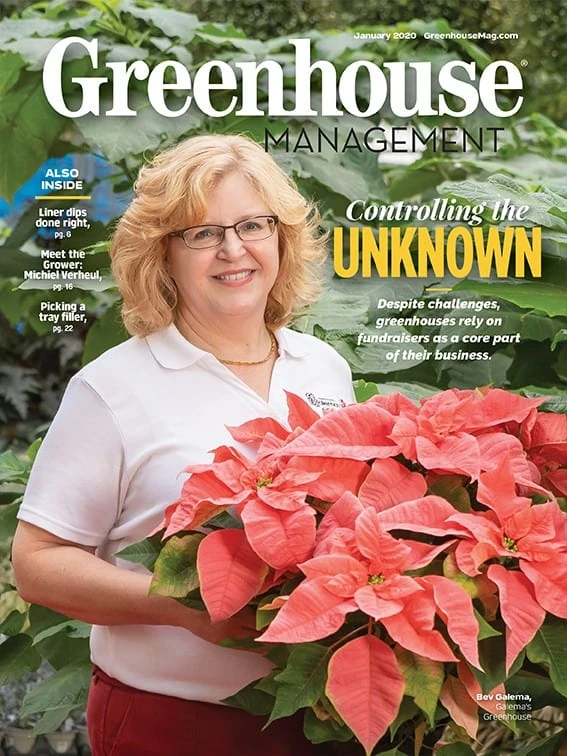

Since 2006, Juan Ponce has applied his agricultural engineering knowledge and entomology expertise to his duties at Metrolina Greenhouses in Huntersville, North Carolina. When this experience is paired with his previous position as an entomologist curator in Medellin, Colombia, it’s safe to say he knows a thing or two about insects.
“When people ask for help, I always say, ‘We need to know our enemy. It’s really hard to kill the enemy if we don’t know the enemy,’” he says. “As soon as we know our enemy, we then need to choose our best guns.”
In this case, the guns Ponce refers to are the variety of chemicals growers use in the greenhouse. However, before they apply chemicals, he says growers should consider three major things.
“Before I apply anything, I know exactly what I’m looking for after scouting my crop and identifying what’s there,” he says. “I then put a procedure in place for what needs to be done, and third, I think about the time of day and condition I have — high humidity, low humidity, dry air, cold air, heat — things like that.”
In fact, Ponce says scouting is the first step in chemical application and is also the most important, since the following actions depend upon what is discovered.
“When we scout, we make the most important decision: what needs to be sprayed,” he says.
But while pesticides are efficient, Ponce says they are not always the “best guns” he previously referred to. For example, the cuttings Metrolina receives are often already contaminated with pests, spider mites, whiteflies and poop. Therefore, Ponce and his team manage those with a “soft option,” like botanicals, biorationals and sometimes sulfur oil.
“With those applications, we do it with the purpose that it will lower the refuel and pesticides and that way, we can introduce our biological without having any heavy, heavy pesticide refuel,” he says.
Along with scouting, Ponce says proper application is important because the success of the application depends on that as well.

For instance, when his team does a nematode application for fungicide control, they set up the sprayer, remove the filter so the nematodes are not caught on it, and most importantly, spray every morning since nematodes do not like light. “Again, when we know our enemy, we know what works,” he says.
Ponce also says speed plays a role in proper application because if technicians move too slow or too fast, the preferred amount of chemical will not be applied. Ponce says that this, combined with a bad technique, can create resistance on some pests since the chemical doses are incorrect.
“When we try to use the same chemical, it won’t have any effect,” he says. “And those are the two main and most important things that come with wrong application and speed — not killing the pests and creating resistance. Then, this means you’re wasting money on labor and on the person applying it.”
Ponce says another way to save money –– aside from ensuring proper methods and application –– is by using beneficial plants to protect good insects. By doing that, they reduce their cost by not buying every week, which in turn, helps them use fewer chemicals overall. In today’s political and educated climate, Ponce says that growers should take this, too, into consideration.
“There are programs that we call ‘calendar spray applications,’ which means that every day, I’ve got to spray one chemical and the next week, spray a new one,” he says. “Those programs were good in the ’90s when chemicals were cheap and when just production was important, but now we know they are pretty harmful for the environment. Today, we have to be proactive and think about what we’re doing. The chemicals are more expensive, and our society is more educated about what we’re doing on the fields, on their vegetables, on their fruits. People already question what we do here and ask how harmful the chemicals are, and now that we have education spreading around, we know that we cannot just go in and start the spraying calendar. We need to see what we have there and base it on what we see. That way, we do the right application the first time.”
However, even with that said, Ponce still says pesticides are important when an infestation occurs, and growers should spend money on the right products.

“If a crop is in danger, the money becomes a second factor,” he says. “We need to save the crop.”
But while some growers may have these steps down, there are other mistakes Ponce notices. One common pitfall circles back to the most important stage –– scouting. When scouting is skipped, growers do not know what they’re aiming for, which taints any of the work that follows. Another mistake is choosing products and not understanding how they work.
“Some growers think everything out there is just meant to kill, but there’s got to be a plan,” he says. “You have to know how receivable it is, how the mode of action is, if it’s systemic or translaminar, how long the chemical will be in the plant and how long it will protect it.”
Ponce also says that sometimes growers go for chemicals that are more widespread to control additional pests, but sometimes that’s counterproductive because since they cover a wide spectrum of insects, they have a smaller chance of pinpointing the exact pests they are looking for.
Because of this, Ponce conducts his own research, tries different chemicals, makes his own applications, creates a chart and ranks them based off their success.
“There’s a ton of chemicals, but not all the chemicals work under the same conditions,” he says. “Weather and different areas affect that. When I try these out, I’m looking for what works for me. Growers should do the same to reach maximum success.”

Explore the January 2020 Issue
Check out more from this issue and find your next story to read.
Latest from Greenhouse Management
- Terra Nova Nurseries introduces rust-free and disease-resistant heucherella
- John T. Nickel, founder of Greenleaf Nursery Co., passes away at 89
- Three tours offered at 2025 Farwest Show
- Garden Media Group announces sixth annual Women in Horticulture Week
- Star Roses and Plants announces National Knock Out Rose Day
- The Growth Industry Episode 4: How federal budget cuts are affecting horticulture nonprofits
- The thrips battle plan
- Pennsylvania Horticultural Society shares top gardening trends from 2025 Philadelphia Flower Show





